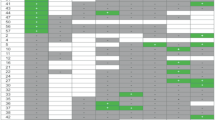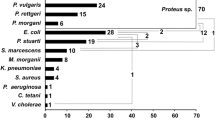Abstract
The objective of the study was to quantitatively measure the number of Oxalobacter formigenes (O. formigenes) colonizations in the gastrointestinal tract in calcium oxalate-forming patients with real-time polymerase chain reaction (PCR). Calcium oxalate-forming patients (n: 27) were included in the study. Serum calcium, sodium, potassium, urea and creatinine levels, as well as 24 h urine levels of calcium and oxalate were measured. The numbers of O. formigenes colonies in stool samples were detected by real-time PCR. One or two metabolic abnormalities were detected in 15 of 27 patients. The O. formigenes levels in patients with metabolic disturbance were significantly decreased when compared to the patients with no metabolic abnormalities (p: 0.038). The undetectable levels of O. formigenes were encountered in one of five patients with hypercalciuria, in three of four patients with hyperoxaluria and in four of six patients with both hypercalciuria and hyperoxaluria. In nine patients with a history of stone recurrence, O. formigenes colonization was significantly lower than the patients with the first stone attack (p: 0.001). O. formigenes formation ceased or significantly diminished in patients with calcium oxalate stones with a coexistence of both hyperoxaluria and hypercalciuria. The measurement of O. formigenes colonies by real-time PCR seemed to be an inconvenient and expensive method. For this reason, the real-time PCR measurements can be spared for the patients with stone recurrences and with metabolic abnormalities like hypercalciuria and hyperoxaluria. The exact measurement of O. formigenes may also help more accurate programming of O. formigenes-based treatments.
Similar content being viewed by others
References
Menon M, Parulkar BG, Drach GW (1988) Urinary lithiasis: etiology, diagnosis and medical management. In: Walsh PC, Retik AB, Vaughan ED Jr, Wein AJ (eds) Campbell’s Urology, vol III, 7th edn. W. B. Saunders Co., Philadelphia, pp 2659–2752
Goldfarb DS (2009) Prospects for dietary therapy of recurrent nephrolithiasis. Adv Chronic Kidney Dis 16:21–29
Borghi L, Meschi T, Maggiore U, Prati B (2006) Dietary therapy in idiopathic nephrolithiasis. Nutr Rev 64:301–312
Bruce AW, Reid G (2003) Probiotics and the urologist. Can J Urol 10:1785–1789
Duncan SH, Richardson AJ, Kaul P et al (2002) Oxalobacter formigenes and its potential role in human health. Appl Environ Microbiol 68:3841–3847
Hatch M, Freel RW (2008) The roles and mechanisms of intestinal oxalate transport in oxalate homeostasis. Semin Nephrol 28:143–151
Mittal RD, Kumar R (2004) Gut-inhabiting bacterium Oxalobacter formigenes: role in calcium oxalate urolithiasis. J Endourol 18:418–424
Mittal RD, Kumar R, Bid HK et al (2005) Effect of antibiotics on Oxalobacter formigenes colonization of human gastrointestinal tract. J Endourol 19:102–106
Sidhu H, Allison M, Peck AB (1997) Identification and classification of Oxalobacter formigenes strains by using oligonucleotide probes and primers. J Clin Microbiol 35:350–353
Troxel SA, Sidhu H, Kaul P et al (2003) Intestinal Oxalobacter formigenes colonization in calcium oxalate stone formers and its relation to urinary oxalate. J Endourol 17:173–176
Mittal RD, Kumar R, Mittal B et al (2003) Stone composition, metabolic profile and the presence of the gut-inhabiting bacterium Oxalobacter formigenes as risk factors for renal stone formation. Med Princ Pract 12:208–213
Prokopovich S, Knight J, Assimos DG et al (2007) Variability of Oxalobacter formigenes and oxalate in stool samples. J Urol 178:2186–2190
Larionov A, Krause A, Miller W (2005) A standard curve-based method for relative real-time PCR data processing. BMC Bioinformatics 21(62):1–16
Sails AD (2004) Applications of real-time PCR in clinical microbiology. In: Edwards K, Logan J, Saunders N (eds) Real-time PCR: an essential guide. Horizon Biosci, Norfolk, pp 247–326
Neuhaus TJ, Belzer T, Blau N et al (2000) Urinary oxalate excretion in urolithiasis and nephrocalcinosis. Arch Dis Child 82:322–326
Kleinschmidt K, Mahlmann A, Hautmann R (1994) Oxalate degrading bacteria in the gut: do they influence calcium oxalate stone formation? In: Ryall R, Bais R, Marshall VR (eds) Urolithiasis 2. Plenum Press, New York, pp 439–441
Hoppe B, Beck B, Gatter N et al (2006) Oxalobacter formigenes: a potential tool for the treatment of primary hyperoxaluria type 1. Kidney Int 70:1305–1311
Sidhu H, Schmidt ME, Cornelius JG et al (1999) Direct correlation between hyperoxaluria/oxalate stone disease and the absence of the gastrointestinal tract-dwelling bacterium Oxalobacter formigenes: possible prevention by gut recolonization or enzyme replacement therapy. J Am Soc Nephrol 10(Suppl 14):S334–S340
Kaufman DW, Kelly JP, Curhan GC et al (2008) Oxalobacter formigenes may reduce the risk of calcium oxalate kidney stones. J Am Soc Nephrol 19:1197–1203
Kwak C, Kim HK, Kim EC et al (2003) Urinary oxalate levels and the enteric bacterium Oxalobacter formigenes in patients with calcium oxalate urolithiasis. Eur Urol 44:475–481
Siva S, Barrack ER, Reddy GP et al (2009) A critical analysis of the role of gut Oxalobacter formigenes in oxalate stone disease. BJU Int 103:18–21
Sidhu H, Holmes RP, Allison MJ et al (1999) Direct quantification of the enteric bacterium Oxalobacter formigenes in human fecal samples by quantitative competitive-template PCR. J Clin Microbiol 37:1503–1509
Kharlamb V, Schelker J, Francois F et al (2011) Oral antibiotic treatment of helicobacter pylori leads to persistently reduced intestinal colonization rates with Oxalobacter formigenes. J Endourol 25:1781–1785
Kelly JP, Curhan GC, Cave DR et al (2011) Factors related to colonization with Oxalobacter formigenes in US adults. J Endourol 25:673–679
Hoppe B, von Unruh G, Laube N et al (2005) Oxalate degrading bacteria: new treatment option for patients with primary and secondary hyperoxaluria? Urol Res 33:372–375
Campieri C, Campieri M, Bertuzzi V et al (2001) Reduction of oxaluria after an oral course of lactic acid bacteria at high concentration. Kidney Int 60:1097–1105
Watterson JD, Cadieux PA, Beiko DT et al (2003) Oxalate-degrading enzymes from Oxalobacter formigenes: a novel device coating to reduce urinary tract biomaterial-related encrustation. J Endourol 17:269–274
Hoppe B, Dittlich K, Fehrenbach H et al (2011) Reduction of plasma oxalate levels by oral application of Oxalobacter formigenes in 2 patients with infantile oxalosis. Am J Kidney Dis 58:453–455
Hoppe B, Groothoff JW, Hulton SA et al (2011) Efficacy and safety of Oxalobacter formigenes to reduce urinary oxalate in primary hyperoxaluria. Nephrol Dial Transpl 26:3609–3615
Author information
Authors and Affiliations
Corresponding author
Rights and permissions
About this article
Cite this article
Batislam, E., Yilmaz, E., Yuvanc, E. et al. Quantitative analysis of colonization with real-time PCR to identify the role of Oxalobacter formigenes in calcium oxalate urolithiasis. Urol Res 40, 455–460 (2012). https://doi.org/10.1007/s00240-011-0449-8
Received:
Accepted:
Published:
Issue Date:
DOI: https://doi.org/10.1007/s00240-011-0449-8




